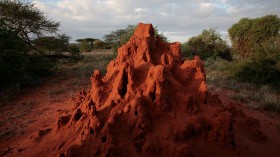The largest living organism, Pando, is communicating with experts through the ultrasonic sounds it is producing.
Ultrasonic Sounds from the Largest Living Tree Pando
The world's largest tree, Pando, a 13 million-pound giant that covers 106 acres in southern Utah, has been the subject of recordings by scientists. The scientists believe that hearing the recordings will help them gain a better picture of the aspen's condition and any potential environmental changes.
Pando looks like a Populus tremuloides (quaking aspen) forest to the untrained eye. It is, however, a single clone made up of over 40,000 genetically identical stems (trunks) that are linked together by an intricate root system.
Jeff Rice, an audio engineer from Seattle, visited Pando last summer. With the use of a hydrophone, he started recording the sounds of animals moving around, birds singing in the trees, and Pando's leaves rustling in the breeze. However, he quickly became interested in what was happening underground.
According to Rice, Pando itself has a stunning interconnection. At the Acoustical Society of America's 184th Meeting on May 10, Rice gave a presentation of his recordings. He explained to Live Science that the noises contain a wide variety of components in addition to a complex subterranean soundscape. The quivering of the leaves is not the only thing present. A lot was happening there, Rice began to realize.
Pando Portal
To further Pando's education and research, Rice partnered with Lance Oditt, the organization's founder and executive director. Using a hydrophone that they nicknamed the "Pando portal"-a huge hole in one of the tree trunks-they started recording below the forest floor while working with Rice, who was its artist-in-residence last summer. The result was a guttural groan-like low, percussive rumble.
He inserted it in much like a plug into a socket after Rice indicated he could reach down into the hole and attach the hydrophone straight to the roots. His crew began to hear intriguing sounds right away, but a low, drone-like sound particularly caught their attention.
They pounded on a branch about a hundred feet from the portal to test their hypothesis that whatever sound they were detecting was being conveyed by Pando's roots. The knock was captured as a thud by the hydrophone.
This helps show that Pando is linked, according to Oditt, and not simply at the soil surface. Instead, the root system is similar to an underground latticework.
Also Read: World's Largest Single Organism Pando is Breaking Down to Smaller Fractions
Pando Talks via Ultrasonic Sounds
Oditt is optimistic that gaining a clearer picture of what's going on below the surface would help researchers better comprehend Pando, which is said to be one of the largest organisms in the world.
The Pando Photographic Survey, which allows anybody with an internet connection to digitally tour Pando, was created throughout several summers by Oditt and a group of volunteers who methodically photographed nearly every square inch, every nook, and cranny of the aspen clone.
The project acts as a baseline to track the tree's evolution through time.
The unreleased recordings provide fresh chances to learn more about the "trembling giant" in a noninvasive method. This entails tracing Pando's root structure, keeping an eye on water flow, and managing animals to prevent deer from devouring the tree and impeding its ability to regenerate.
According to Oditt, the team may utilize sound to track the plant's root system and listen for any changes in the water and soil that are occurring underground. To cope with the deer problem, the team may also track illness and discharge ultrasonic noises, Live Science reports.
Related Article: Vast Aspen Grove Pando Slowly Dies from Grazing Wildlife
© 2024 NatureWorldNews.com All rights reserved. Do not reproduce without permission.





